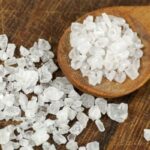We explain what lithium is and where this chemical element comes from. Discovery, uses and presence in the human body.

What is lithium?
Lithium (Li) is an alkaline, metallic, diamagnetic but highly reactive chemical element rapid oxidation in air or water. In its pure form it is a soft metal, silvery white in color and extremely light, which is not found in a free state in nature.
It is an element similar to sodium, moderately abundant on our planet, especially in volcanic routes or salt flats (85% of its reserves are found in Bolivian, Chilean and Argentine territory). Along with hydrogen and helium, lithium It is one of the very first elements of the universe whose creation would respond to the same big Bang.
Its name comes from the Greek word lithios, which means “stone”, since it was discovered in ancient times as part of large rocks. Its modern understanding dates back to 1817, when Johann Arfvedson discovered it in a petalite mine in Sweden. Its production through electrolysis was much later, however, and its commercialization began in 1923 by a German company.
Like other alkali metals, lithium It is highly flammable and potentially explosive once exposed to air or, even more, to the water. It is also corrosive and in large quantities can be toxic, by inhibiting the absorption of iodine vital for thyroid hormones.
Lithium on the Periodic Table
Lithium is represented by the chemical symbol Li and is found in the Periodic Table in group 1, along with the rest of the alkali metals such as sodium (Na), potassium (K), rubidium (Rb), cesium (Cs) and francium (Fr). Its atomic number is 3.


Uses of lithium

Lithium has the following applications:
- Psychotropic drugs. Lithium salts (such as lithium carbonate) are used in psychiatric medicine as a mood stabilizer, inhibiting episodes of mania and depression associated with bipolar illness and other mood disorders.
- Blotters Compounds such as lithium nitrate, lithium chloride or lithium bromide have high hygroscopicity, that is, they greatly absorb atmospheric humidity, and thus allow the air to dry in closed compartments.
- Debuggers To extract carbon dioxide from the air, lithium hydroxide is used as a scrubber in submarines and spacecraft.
- Alloys. It is used in alloys with aluminum, cadmium, copper and manganese to manufacture ceramics, lenses, and in aeronautical construction.
- Lubricants Certain salts of lithium and stearic acid, such as lithium stearate, are used in the manufacture of lubricants for use at high temperatures.
- Battery manufacturing. Its electrochemical potential makes it ideal for the anode (positive pole) of electric batteries.
Lithium in the human body
Lithium can cause damage to the human body for example, upon contact with the skin. Being a powerful desiccant, it quickly extracts moisture from it, causing burns.
The intake of compounds with lithium in controlled quantities can be beneficial in the face of certain psychiatric conditions since it acts on certain neurotransmitters, stabilizing the mood.
However, it increases cell permeability by replacing sodium in cell membranes, preventing the production of the sodium potassium ATPase substrate pump, which is toxic on a large scale.





